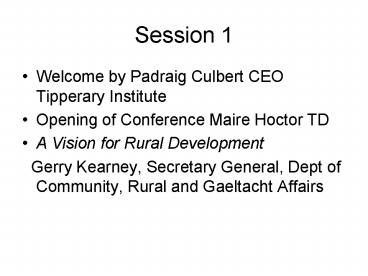Welcome by Padraig Culbert CEO Tipperary Institute - PowerPoint PPT Presentation
1 / 15
Title:
Welcome by Padraig Culbert CEO Tipperary Institute
Description:
Gerry Kearney, Secretary General, Dept of Community, ... A Collaborative approach to decision making. Introduction. Catherine Corcoran. Tipperary Institute ... – PowerPoint PPT presentation
Number of Views:31
Avg rating:3.0/5.0
Title: Welcome by Padraig Culbert CEO Tipperary Institute
1
Session 1
- Welcome by Padraig Culbert CEO Tipperary
Institute - Opening of Conference Maire Hoctor TD
- A Vision for Rural Development
- Gerry Kearney, Secretary General, Dept of
Community, Rural and Gaeltacht Affairs
2
Integrated Area Planning
- A Collaborative approach to decision making
- Introduction
- Catherine Corcoran
3
Tipperary Institute
- Tipperary Institute (TI) was established in 1999
as Irelands only institute exclusively devoted
to rural development - Academic Courses
- Outreach work
- Research work
- for clients in the Community,
- Business and State sectors
4
Rural Planning-Why?
- Growth producing uneven outcomes for certain
areas/groups - Certain Villages/DEDs growing/others contracting
- Lack of services in many rural areas
- Uneven provision
- Many requests for
- assistance
5
Many requests for assistance
- Crusheen/Ballinruan, Co Clare
- Ferbane, Co Offaly
- Eyrecourt, Co Galway
- Kinvara, Co. Galway
- Hacketstown, Co Carlow
- Kilmacthomas, Co Waterford
6
2 Types of Rural?
- Urban Fringe
- High demand for housing
- Commuter culture
- Demand on services such as schools/clinics
- Pressure on local infrastructure
- Traffic control
- Integration of new residents
- Areas in Decline
- Population decline
- Loss of young people
- Lack employment
- Service closure
- Age-dependency
- Lack of housing development
- Lack of investment
7
Rural Planning-Why?
- Breakdown in trust/relationships
- Clash of visions
- Planners/State policy-Concentration of population
- Rural/farming lobby-Opposed to concentration?
8
Rural Planning-Why?
- ?What are the rural areas for?
- ?Who decides?
- ? How are these decisions/non-decisions made?
9
Rural Planning-Why?
- Lack of shared Vision
- The planning process lacks mechanisms for
addressing this issue - Communities asked to participate in consultative
processes when decisions/visions are already set
10
What is IAP?
- IAP a partnership approach to local development
- Developing shared vision
- Varying interests
- Common cause
11
What is IAP?
- Empowering
- Practical Participatory
- Process
- Local people and experts together
- collect, analyse compile information
- Developing skills Developing structures
- Prepare and implement
- An Inclusive and multifaceted plan
12
Principles
- The plan will be developed using an action
planning model - to enable the local community to identify,
analyse and address the needs in their community.
- build local capacity and equip community members
with the knowledge, skills and motivation - mobilise community, state and private effort in
addressing the development of their area. - Integrated area planning assumes a commitment to
working in an inclusive and participatory way - diverse, inclusive and committed to a partnership
approach to local development.
13
Principles
- The process should take an integrated approach to
sustainable planning - An integrated development plan should incorporate
a balance between social, economic and
environmental needs and measures. - The process will endeavour to ensure that the
outcomes are equitable, realistic and
sustainable. - Development plans should be clear and accessible.
- The process should be committed to ongoing
community communication. - As each stage of the process is advanced, regular
communication will be required with the local
community and the agencies involved.
14
Principles
- The planning process should seek to develop
structures for implementation. - to engage state agencies fully at local and
county level in inputting to the plan - taking responsibility for relevant parts of its
implementation in partnership with the local
community. - should seek to develop clear visions, goals and
objectives, with actions clearly linked to the
attainment of agreed outcomes.
15
Participation, Collaboration and the Development
of Rural areas
- ?What are the rural areas for?
- ?Who decides?
- ? How are these decisions/non-decisions made?































